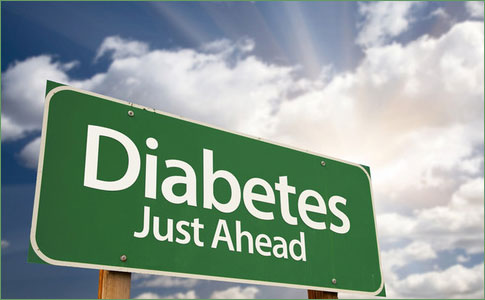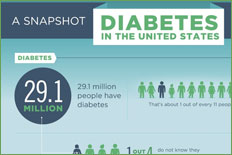Health Centers > Diabetes Center > Hyperglycemic Hyperosmolar state
Hyperglycemic Hyperosmolar state
Introduction
- Hyperglycemia > 600 mg/dL.
- Serum osmolality > 310 mosm/kg.
- No acidosis; blood pH above 7.3.
- Serum bicarbonate > 15 mEq/L.
- Normal anion gap (< 14 mEq/L).
General Considerations
Diabetic Coma
Hyperglycemic coma
Diabetic Ketoacidosis
Introduction
General Considerations
Clinical Findings
L SYMPTOMS AND SIGNS
L LABORATORY FINDINGS
Complications
L HYPERGLYCEMIA
L KETOACIDEMIA
L FLUID AND ELECTROLYTE DEPLETION
Treatment
L PREVENTION
L EMERGENCY MEASURES
Prognosis
Hyperglycemic Hyperosmolar state
+ Introduction
+ General Considerations
+ Pathogenesis
+ Clinical Findings
+ Treatment
+ Prognosis
Lactic Acidosis
- Introduction
- General Considerations
- Clinical Findings
- Treatment
- Prognosis
This second most common form of hyperglycemic coma is characterized by severe hyperglycemia in the absence of significant ketosis, with hyperosmolality and dehydration. It occurs in patients with mild or occult diabetes, and most patients are at least middle-aged to elderly. Accurate figures are not available as to its true incidence, but from data on hospital discharges it is rarer than diabetic ketoacidosis even in older age groups. Lethargy and confusion develop as serum osmolality exceeds 310 mosm/kg, and coma can occur if osmolality exceeds 320-330 mosm/kg.
A committee of the ADA has recommended replacing the previous name of this disorder (hyperglycemic, hyperosmolar, nonketotic coma) with the consensus term "hyperglycemic hyperosmolar state." Underlying renal insufficiency or congestive heart failure is common, and the presence of either worsens the prognosis. A precipitating event such as infection, myocardial infarction, stroke, or recent operation is often present. Certain drugs such as phenytoin, diazoxide, corticosteroids, and diuretics have been implicated in its pathogenesis, as have procedures associated with glucose loading such as peritoneal dialysis.
Pathogenesis
A partial or relative insulin deficiency may initiate the syndrome by reducing glucose utilization of muscle, fat, and liver while inducing hyperglucagonemia and increasing hepatic glucose output. With massive glycosuria, obligatory water loss ensues. If a patient is unable to maintain adequate fluid intake because of an associated acute or chronic illness or has suffered excessive fluid loss, marked dehydration results. As plasma volume contracts, renal insufficiency develops, and the resultant limitation of renal glucose loss leads to increasingly higher blood glucose concentrations. Severe hyperosmolality develops that causes mental confusion and finally coma. It is not clear why ketosis is virtually absent under these conditions of insulin insufficiency, although reduced levels of growth hormone may be a factor, along with portal vein insulin concentrations sufficient to restrain ketogenesis.
The Hypoglycemic States
Spontaneous hypoglycemia in adults is of two principal types: fasting and postprandial. Symptoms begin ...
Clinical Findings
A. SYMPTOMS AND SIGNS
Onset may be insidious over a period of days or weeks, with weakness, polyuria, and polydipsia. The lack of features of ketoacidosis may retard recognition of the syndrome and delay therapy until dehydration becomes more profound than in ketoacidosis. Reduced intake of fluid is not an uncommon historical feature, due to either inappropriate lack of thirst, nausea, or inaccessibility of fluids to elderly, bedridden patients. Lethargy and confusion develop, progressing to convulsions and deep coma. Physical examination confirms the presence of profound dehydration in a lethargic or comatose patient without Kussmaul respirations.
B. LABORATORY FINDINGS
Severe hyperglycemia is present, with blood glucose values ranging from 600 mg/dL to 2400 mg/dL. In mild cases, where dehydration is less severe, dilutional hyponatremia as well as urinary sodium losses may reduce serum sodium to 120-125 mEq/L, which protects to some extent against extreme hyperosmolality. However, as dehydration progresses, serum sodium can exceed 140 mEq/L, producing serum osmolality readings of 330-440 mosm/kg. Ketosis and acidosis are usually absent or mild. Prerenal azotemia is the rule, with serum urea nitrogen elevations over 100 mg/dL being typical.
Treatment
A. SALINE
Fluid replacement is of paramount importance in treating nonketotic hyperglycemic coma. The onset of hyperosmolarity is more insidious in elderly people without ketosis than in younger individuals with high serum ketone levels, which provide earlier indicators of severe illness (vomiting, rapid deep breathing, acetone odor, etc). Consequently, diagnosis and treatment are often delayed until fluid deficit has reached levels of 6-10 L.
If hypovolemia is present as evidenced by hypotension and oliguria, fluid therapy should be initiated with 0.9% saline. In all other cases, 0.45% saline appears to be preferable as the initial replacement solution because the body fluids of these patients are markedly hyperosmolar. As much as 4-6 L of fluid may be required in the first 8-10 hours. Careful monitoring of the patient is required for proper sodium and water replacement. Once blood glucose reaches 250 mg/dL, fluid replacement should include 5% dextrose in either water, 0.45% saline solution, or 0.9% saline solution. The rate of dextrose infusion should be adjusted to maintain glycemic levels of 250-300 mg/dL in order to reduce the risk of cerebral edema. An important end point of fluid therapy is to restore urinary output to 50 mL/h or more.
B. INSULIN
Less insulin may be required to reduce the hyperglycemia in nonketotic patients as compared to those with diabetic ketoacidotic coma. In fact, fluid replacement alone can reduce hyperglycemia considerably by correcting the hypovolemia, which then increases both glomerular filtration and renal excretion of glucose. An initial dose of 0.15 unit/kg is followed by an insulin infusion of 1-2 units/h, which is titrated to lower blood glucose levels by 50-70 mg/dL per hour.
C. POTASSIUM
With the absence of acidosis, there may be no initial hyperkalemia unless associated renal failure is present. This results in less severe total potassium depletion than in diabetic ketoacidosis, and less potassium replacement is therefore needed. However, because initial serum potassium is usually not elevated and because it declines rapidly as a result of insulin's effect on driving potassium intracellularly, it has been recommended that potassium replacement be initiated earlier than in ketotic patients, assuming that no renal insufficiency or oliguria is present. Potassium chloride (10 mEq/L) can be added to the initial bottle of fluids administered if the patient's serum potassium is not elevated.
D. PHOSPHATE
If severe hypophosphatemia (serum phosphate < 1 mg/dL [< 0.32 mmol/L]) develops during insulin therapy, phosphate replacement can be given as described for ketoacidotic patients (at 3 mmol/h).
Prognosis
The overall mortality rate of hyperglycemic, hyperosmolar, nonketotic coma is more than ten times that of diabetic ketoacidosis, chiefly because of its higher incidence in older patients, who may have compromised cardiovascular systems or associated major illnesses and whose dehydration is often excessive because of delays in recognition and treatment. (When patients are matched for age, the prognoses of these two hyperglycemic emergencies are reasonably comparable.) When prompt therapy is instituted, the mortality rate can be reduced from nearly 50% to that related to the severity of coexistent disorders.
Bibliography
Hyperglycemic crises in patients with diabetes mellitus. Diabetes Care 2001;24:154. [PMID: 11221603]
Trence DL et al: Hyperglycemic crisis in diabetes mellitus type 2. Endocrinol Metab Clin North Am 2001;30:817. [PMID: 11727401]


